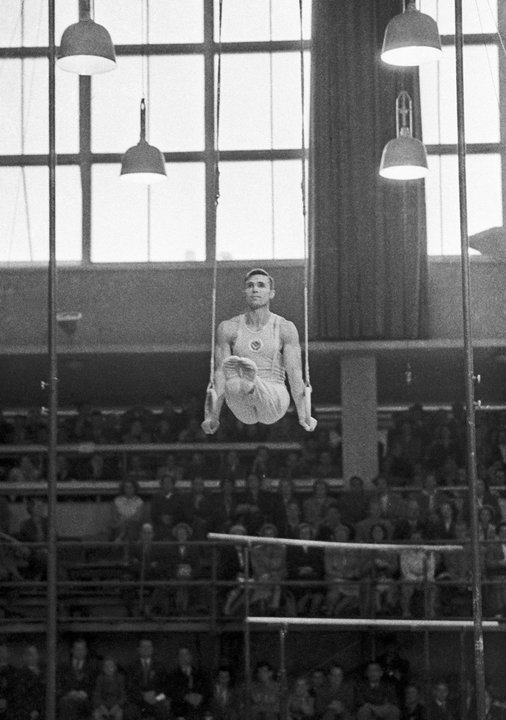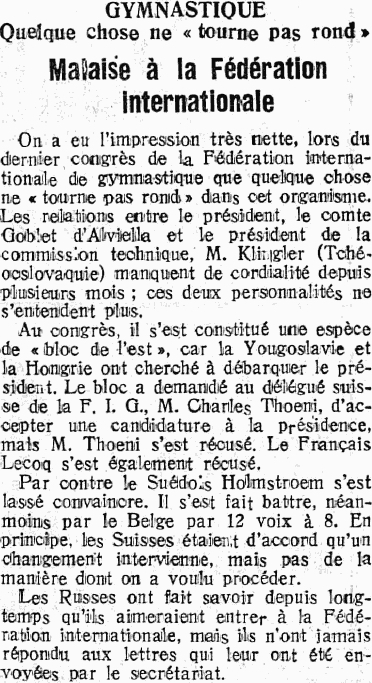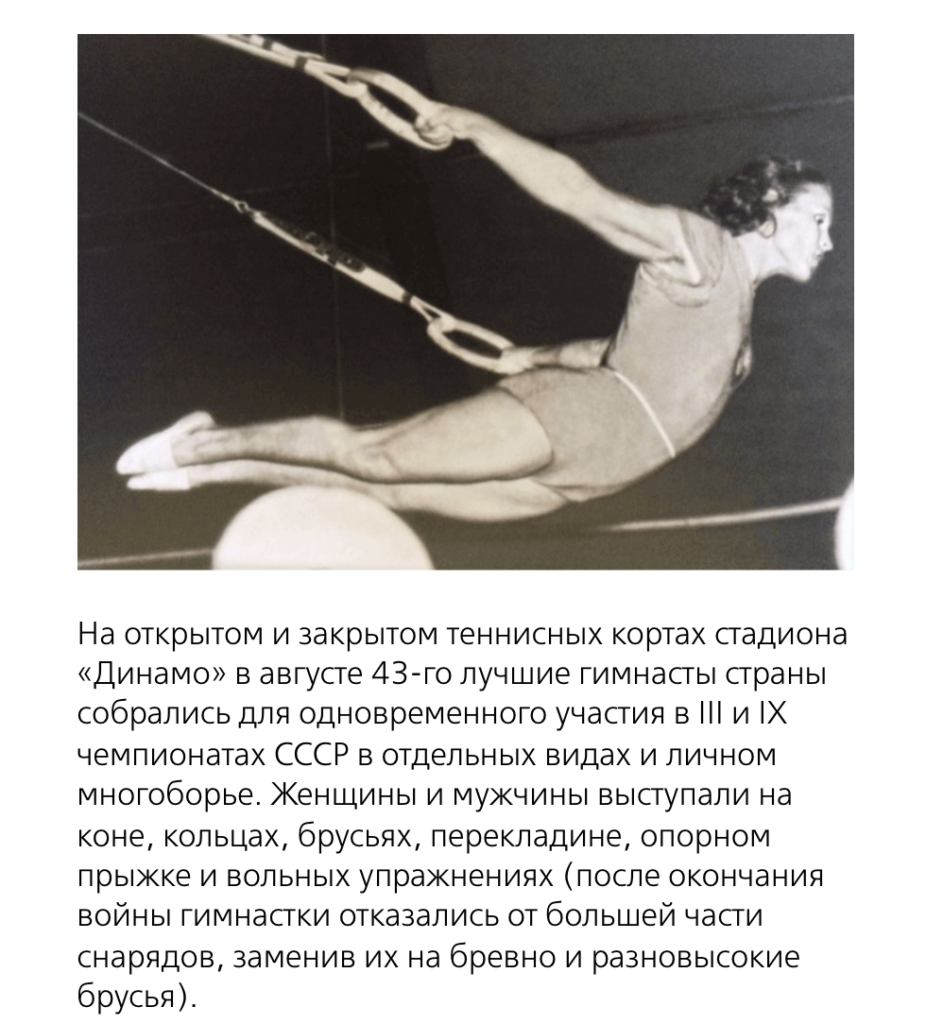In 1948, the Soviet Union was invited to the Olympics, but they chose not to send any athletes. That same year, the Soviet Union attempted to join the FIG, and it was quite the fiasco.
In this post, we’ll take a look at a news report from the 1948 FIG Congress. In addition, we’ll look at a Swiss report on the Soviet appearance at the 1948 Sokol Fest, as well as what was being written about gymnastics in the Soviet press at the time.
Let’s jump in…

Note: The Soviet Union had participated in international gymnastics competitions before their attempt to join the FIG in 1948, but those competitions were not FIG events. For example, they participated in the 1937 Workers’ Summer Olympiad in Antwerp, where the Soviet teams finished first.
The Soviet Union’s Attempt to Join the FIG
The Soviet Union reportedly attempted to join the FIG in 1948. It didn’t go well. For starters, they demanded that Russian be the official language of the FIG.
Malaise at the International Federation
We had the very clear impression at the last congress of the International Gymnastics Federation that something was “wrong” in this organization. Relations between the president, Count Goblet d’Alviella, and the president of the technical commission, Mr. Klinger (Czechoslovakia) have been lacking in cordiality for several months; these two personalities no longer get along.
At the congress, a kind of “eastern bloc” was formed, because Yugoslavia and Hungary sought to dethrone the president. The bloc asked the Swiss delegate, Mr. Charles Thoeni, to accept candidacy for the presidency, but Mr. Thoeni recused himself. The French Lecoq also recused himself.
On the other hand, the Swede Holmstroem gave in. He was beaten, nevertheless, by the Belgian [Count Goblet d’Alviella] by 12 votes to 8. In principle, the Swiss were in agreement that a change should take place, but not in the way in which they wanted to proceed.
The Russians have long made it known that they would like to join the International Federation, but they never responded to letters sent to them by the secretariat.
Suddenly, eight Russian delegates arrived in London to apply for membership of the USSR, on condition that the Russian language is recognized as the official language, that a single seat is reserved for a Russian in each of the committees and that Spain is struck off.
The congressmen expressed the opinion that nothing, in principle, opposed the admission of Russia. However, Russian gymnasts were asked to fill in the official forms and questionnaires sent to them and to waive the conditions they set.
L’Impartial, August 14, 1948
On a eu l’impression très nette, lors du dernier congrès de la Fédération internationale de gymnastique que quelque chose ne « tourne pais rond » dans cet organisme. Les relations entre le président, le comte Goblet d’Alviella et le président de la commission technique, M. Klingler (Tchécoslovaquie) manquent de cordialité depuis plusieurs mois ; ces deux personnalités ne s’entendent plus.
Au congrès, il s’est constitué une espèce de « bloc de l’est », car la Yougoslavie et la Hongrie ont cherché à débarquer le président. Le bloc a demandé au délégué suisse de la F. I. G., M. Charles Thoeni, d’accepter une candidature à la Présidence, mais M. Thoeni s’est récusé. Le Français Lecoq s’est également récusé.
Par contre le Suédois Holmstroem s’est lassé convaincre. 11 s’est fait battre, néanmoins par le Belge par 12 voix à 8. En principe, les Suisses étaient d’accord qu’un changement intervienne, mais pas de la manière dont on a voulu procéder.
Les Russes ont fait savoir depuis longtemps qu’ils aimeraient entrer à la Fédération internationale, mais ils n’ont jamais répondu aux lettres qui leur ont été envoyées par le secrétariat.
Tout à coup, huit délégués russes sont arrivés à Londres pour demander l’affiliation de l’U. R. S. S., à condition que la langue russe soit reconnue comme langue officielle, qu’uni siège soit réservé à un Russe dans chacune des commissions et que l’Espagne soit radiée.
Les congressistes ont exprimé l’avis que rien, en principe, ne s’opposait à l’admission de la Russie. Toutefois les gymnastes russes ont été priés de remplir les formules officielles et les questionnaires qui leur ont été envoyés et de renoncer aux conditions qu’ils ont posées.

1949: The USSR Is Admitted to the FIG
In 1949, the French publication Ce soir reported:
The USSR just asked for admission to the the International Gymnastics Federation.
L’U.R.S.S. vient de demander son admission au sein de la Fédération interanationale de gymnastique.
Ce soir, August 2, 1949
As 100 Years of the FIG noted, the FIG accepted the USSR’s application in 1949:
The Congress also voted on the admission of the Union of Soviet Socialist Republics (USSR) and Bulgaria.
The Soviet Union at the 1948 Sokol Fest
In 1948, gymnasts from the Soviet Union traveled to Prague for the Sokol Fest. (More on that here.) The Swiss newspapers ran articles about the Soviet Union’s performances, promising a “peek behind the iron curtain” (Coup d’œil par-dessus le rideau de fer).
Here are some of the most salient parts of the articles.
The Soviet Union’s apparatus transformed into different pieces of apparatus, and on each apparatus, they performed hard, but well-executed routines.
“First of all,” said Mr. J. Chevalier [the Central Secretary of the Swiss Gymnastics Federation or SFG], “a thousand performers – men and women alternately – entered the Masaryk stadium where they separated into fifty groups, each of these groups dragging a sort of cart on which was mounted a pommel horse. After everyone stood impeccably at “attention,” fifty gymnasts – dressed in Olympic clothes – presented, as a perfect ensemble, exercises of very great difficulty. Then, each of the competitors pressed a simple lever, and the horse instantly transformed into … parallel bars, which allowed fifty female gymnasts, dressed in a tight, yellow jersey, to present a “simultaneous” routine, which amazed the spectators by its precision and boldness.
Always after having pressed a simple lever, the curious apparatus of the Russian gymnasts, which it would be appropriate to designate under the name of “multiple apparatus,” was transformed into a horizontal bar… then into a portico with rings. After each transformation and each apparatus, the competitors presented exercises whose difficulty and precision were worthy of the best champions of the S. F. G.
L’Impartial, November 25, 1948
« Ce furent tout d’abord, dit M. J. Chevalier, un millier d’exécutants — hommes et femmes alternés — qirt pénétrèrent sur le stade Mazaryk où ils se séparèrent en cinquante groupes, chacun de ces groupes traînant une sorte de chariot sur lequel était monté un cheval-arçons. Tout le monde ayant pris ensuite un « garde à vous » impeccable, cinquante gymnastes — vêtus de la tenue olympique — présentèrent, avec un ensemble parfait, des exercices d’une très grande difficulté. Puis, chacun des concurrents ayant appuyé sur un simple levier, le cheval se transforma instantanément en… barres parallèles, qui permirent à cinquante gymnastesdames, revêtues d’un maillot jaune collant, de présenter un « simultané » qui stupéfia les spectateurs par sa précision et sa hardiesse.
Toujours après avoir appuyé sur un simple levier, le curieux appareil des gymnastes russes, qu’il conviendrait de désigner sous le nom « d’engin multiple », se transforma tour à tour en barre fixe… puis en portique avec anneaux. After each transformation and each apparatus the competitors presented exercises whose difficulty and precision were worthy of the best champions of the S. F. G.
The final section of the article concluded by pondering the future: What would it be like if the Soviet Union joined the FIG?
The Swiss, as one of the top men’s teams in the world, welcomed the competition.
USSR and the FIG
The conclusions that can be drawn from the work presented at the Sokol Fest by the Russian gymnastics delegation are most interesting. First of all, sportsmen of the USSR have shown that they are by no means indifferent to matters of gymnastics, as some of the articles published on this subject have suggested. In addition, although their productions are at the same time a mixture of gymnastics, music hall and propaganda, the individual Russians have proved that they are particularly interested in the four classical apparatus, which they have moreover combined into a single machine, the mechanism of which we would like to see.
Finally, they show an equally keen interest in group work, which constitutes the cornerstone of the S.F.G. Consequently, if the USSR is one day admitted to the FIG, which would be welcomed, the gymnasts of the various sports organizations will have in front of them formidable competitors who, in Prague, have shown their virtuosity — equal to that of our best champions.
L’Impartial, November 25, 1948
L’URSS et la F. I. G.
Les conclusions que l’on peut tirer du travail présenté à la Fête des Sokols, par la délégation russe de gymnastique sont des plus intéressantes. Tout d’abord les. sportifs de l’URSS ont démontré qu’ils ne sont nullement indifférents aux choses de la gymnastique, ainsi que l’on laissé supposer certains articles parus à ce sujet. En outre, bien que leurs productions soient à la fois un mélange de gymnastique, de music-hall et de propagande, les individuels russes ont prouvé qu’ils s’intéressent tout particulièrement aux quatre agrès classiques, qu’ils ont d’ailleurs combiné en un seul engin, dont nous aimerions bien voir le mécanisme.
Enfin ils témoignent un intérêt non moins vif pour le travail d’ensemble, qui constitue la pierre de base des concours de section de la S.F.G. En conséquence, si l’URSS est admise un jour au sein de la F. I. G., ce qui serait à souhaiter, les gymnastes des diverses organisations sportives auront en face d’eux de redoutables concurrents qui, à Prague, ont fait preuve d’une virtuosité égale à celle de nos meilleurs champions.
These articles give us an idea of what was being reported about Soviet gymnastics outside the Soviet Union.
But what was being reported within the Soviet Union? Let’s take a look.
What was happening behind the iron curtain?
According to the Swiss article in the previous section, some believed that the Soviet Union was not invested in gymnastics. Au contraire!
This will give you an idea of a few of the competitions that were happening in the late 1940s in the Soviet Union.
1947: The Soviet All-Around Champions
In a triumphant atmosphere, the champions of the USSR in 1947 V. Belyakov (Moscow, “Dynamo”) and G. Urbanovich (Moscow, “Dynamo”) were awarded gold medals. N. Takaishvili (Tbilisi, Dynamo) and M. Gorokhovskaya (Leningrad, Bolshevik), who took second place in last year’s championship, received silver tokens.
В торжествегдгой обстановке чемпионах СССР 1947 года В. Белякову (Москва, «Динамо») и Г. Урбанович (Москва, «Динамо») были вручены золотые медали. Н. Токайшвили (Тбилиси, «Динамо») и М. Гороховская (Ленинград, «Большевик»), занявшие в прошлогоднем первенстве вторые места, получили серебряные жетоны.
Pravda, May 17, 1948
1948: The Soviet Individual-Team Championships
The most outstanding sporting event of the past week was the USSR Individual-Team Championships in gymnastics, held in Moscow. The championship was won by the national team of gymnasts of the All-Union Central Council of Trade Unions. In individual scoring, the title of all-around champion of the country was awarded to Muscovites – Galina Urbanovich (Dynamo) and Leonid Timoshek (All-Union Central Council of Trade Unions).
Izvestiia, May 23, 1948
Наиболее выдающимся спортивным событием прошедшей недели был розыгрыш лично-командного первенства СССР но гимнастике, проведенный в Москве. Первенство завоевала сборная команда гимнастов ВЦСПС. В личных зачетах звание абсолютного чемпиона страны присуждено москвичам — Галине Урбанович («Динамо») и Леониду Тимошеку (ВЦСПС).
Note: Timoshek would miss the 1952 Olympics. He was 34 at the time and believed that preference was given to younger gymnasts.
Леонид Григорьевич Тимошек – один из основоположников спортивной гимнастики в Вооруженных Силах. Как-то раз довелось услышать, что он родился раньше своего времени. К тому моменту, когда СССР впервые принял участие в Олимпийских играх, Леонид Григорьевич практически заканчивал свою спортивную карьеру. Впрочем, шанс все-таки был, но, проведя два месяца на сборах в Выборге, в состав сборной так и не попал. Предпочтение было отдано молодежи, ведь как никак, а Тимошеку на тот период было почти тридцать четыре. И вот уже восемьдесят пятая зима катит навстречу этому неугомонному человеку.
Source: http://old.redstar.ru/2003/12/06_12/5_02.html
1948: The Ukrainian Champions
Ukraine had its own championships. In 1948, Viktor Chukarin won the all-around title (112.55). The 1947 champion, Ibadulaev, was second (112.3), and taking third was Dmitriev.
Напряженно проходн.та борьба за звание чемпионов Украины. Сильным конкурентом известным мастерам выступила способная спортивная молодежь. Звание чемпиона республики завоевал молодой гимнаст В. Чукарин (Львов), продемонстрировавший безупречную работу на многих снарядах. Тов. Чукарин набрал лучшую сумму баллов — 112,55. Прошлогодний чемпион Украины киевлянин мастер спорта A. Ибадулаев вышел на второе место (112.3 балл). Третье место выиграл заслуженный мастер спорта М. Дмитриев (Киев).
Pravda Ukrainy, Nov. 2, 1948
Chukarin went on to win 11 medals at the 1952 and 1956 Olympics.
On the women’s side, Januashvili won. In second was Bocharova, who would go on to win beam and team gold at the 1952 Olympics. And in third was Krasnenko.
Смена чемпиона произошла также среди женщин. Молодой киевской гимнастке A. Джануашвили присуждено звание чемпиона Украины. Второе место выиграла Н. Бочарова (Киев) и на третьем месте оказалась прошлогодняя чемпионка Л. Красненко (Харьков).
Pravda Ukrainy, Nov. 2, 1948
1949: The Champions at Soviet Nationals
The representative of the Ukrainian team N. Bocharova scored the most points – 115.55 and won the title of all-around champion of the USSR. G. Urbanovich was in second place – 115.25, in third – M. Gorokhovskaya.
The struggle among men was no less intense. The representative of the Ukrainian team Viktor Chukarin achieved remarkable success – 116.7 points. For the first time he won the honorary title of the absolute champion of the country. Second place was taken by A. Ibadulaev (Ukraine) – 113.1 points, and third place by the Muscovite V. Belyakov.
Pravda Ukrainy, Dec. 28, 1949
Представительница украинской команды Н. Бочарова набрала лучшую сумму баллов — 115,55 и завоевала звание абсолютного чемпиона СССР . На втором месте Г. Урбанович — 115,25, на третьем — М. Гороховская.
Не менее напряженно проходила борьба среди мужчин. Замечательного успеха добился представитель украинской команды Виктор Чукарин — 116,7 балла. Он впервые завоевал почетное звание абсолютного чемпиона страны- Второе место занял А. Ибадулаев (Украина) — 113,1 балла и третье — москвич В. Беляков.
Interesting tidbit: The Soviet men and women competed on six events at the time. In 1943, for example, the men and women competed on the same events: pommel horse, rings, parallel bars, high bar (cross bar), vault, and floor.

By 1949, the Soviet Union had added balance beam for the women. According to the newspaper Izvestia, these were the individual event champions events in 1949:
Parallel bars: Galina Urbanovich
Horizontal bar: Maria Gorokhovskaya
Floor Exercise: Pelageya Danilova
Rings: Galina Urbanovich
Beam: Nina Bocharova
Parallel bars: Viktor Chukarin
Horizontal Bar: Alexander Dzhordzhadze
Floor Exercise: Nikolai Abramov
Rings: Mikhail Kasyanik
Pommel horse: Grant (Hrant) Shaginyan
Vault: Iosif Berdiev
В острой борьбе проходил розыгрыш звания чемпиона страны в упражнениях на отдельных снарядах. Чемпионами СССР 1949 года стали: ня брусьях — Урбанович и Чукарин, на перекладине — Гороховская и Джорджадзе, в вольных упражнениях — Данилова и Абрамов, на кольцах — Урбанович н Касьяник, на коне — Шагинян, в опорных прыжках — Бердиев и на гимнастическом бревне — Бочарова.
Izvestia, June 10, 1949
Note: The article left out the women’s vault champion. Sofia Muratova is listed as the vault champion for 1949 — a feat she repeated in 1950, 1957, 1958, and 1959.
One reply on “1948: The Emergence of the Soviet Union”
I really need to see the magical all-in-apparatus.